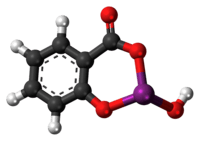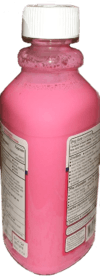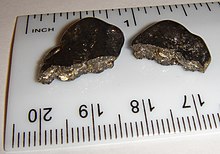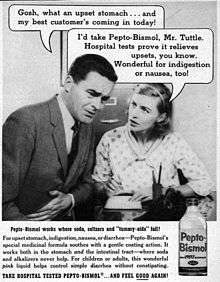Bismuth subsalicylate
Bismuth subsalicylate, sold as generic and under the brand name Pepto-Bismol, is an antacid elixir medication used to treat temporary discomforts of the stomach and gastrointestinal tract, such as nausea, heartburn, indigestion, upset stomach, and diarrhea. It is also commonly known as pink bismuth, but Pepto-Bismol has become a genericized trademark for the substance.
 | |
 | |
| Clinical data | |
|---|---|
| Trade names | Pepto-Bismol |
| AHFS/Drugs.com | Multum Consumer Information |
| MedlinePlus | a607040 |
| Routes of administration | Oral |
| ATC code |
|
| Legal status | |
| Legal status |
|
| Identifiers | |
| |
| CAS Number | |
| PubChem CID | |
| DrugBank | |
| ChemSpider | |
| UNII | |
| KEGG | |
| ChEBI | |
| ChEMBL | |
| CompTox Dashboard (EPA) | |
| ECHA InfoCard | 100.035.397 |
| Chemical and physical data | |
| Formula | C7H5BiO4 |
| Molar mass | 362.093 g·mol−1 |
| 3D model (JSmol) | |
| |
| |
| | |
Bismuth subsalicylate has the empirical chemical formula of C7H5BiO4,[1] and it is a colloidal substance obtained by hydrolysis of bismuth salicylate (Bi(C6H4(OH)CO2)3).
Medical uses

As a derivative of salicylic acid, bismuth subsalicylate displays anti-inflammatory[2] and bactericidal action.[3] It also acts as an antacid.
Adverse effects
There are some adverse effects. It can cause a black tongue and black stools in some users of the drug when it combines with trace amounts of sulfur in saliva and the colon to form bismuth sulfide.[4] Bismuth sulfide is a highly insoluble black salt, and the discoloration seen is temporary and harmless.
Long-term use (greater than 6 weeks) may lead to accumulation and toxicity.[5] Some of the risks of salicylism can apply to the use of bismuth subsalicylate.[6][7][8]
Children should not take medication with bismuth subsalicylate while recovering from influenza or chicken pox, as epidemiologic evidence points to an association between the use of salicylate-containing medications during certain viral infections and the onset of Reye syndrome.[9] For the same reason, it is typically recommended that nursing mothers not use medication containing bismuth subsalicylate because small amounts of the medication are excreted in human breast milk, and these pose a theoretical risk of Reye's syndrome to nursing children.[10]
Salicylates are very toxic to cats, and thus bismuth subsalicylate should not be administered to cats.[11]
The British National Formulary does not recommend bismuth-containing antacids (unless chelated), cautioning that absorbed bismuth can be neurotoxic, causing encephalopathy, and that such antacids tend to be constipating.[12]
Mechanism of action
Bismuth subsalicylate is used as an antacid and antidiarrheal, and to treat some other gastrointestinal symptoms, such as nausea. The means by which this occurs is still not well documented. It is thought to be some combination of the following:[13]
- Stimulation of absorption of fluids and electrolytes by the intestinal wall (antisecretory action)
- As a salicylate, reducing inflammation/irritation of stomach and intestinal lining through inhibition of prostaglandin G/H synthase 1/2
- Reduction in hypermotility of the stomach
- Binding of toxins produced by Escherichia coli
- Bactericidal action of a number of its subcomponents, including salicylic acid[14]
- Bactericidal action via a so-called oligodynamic effect in which small amounts of heavy metals such as bismuth damage many different bacteria species.
- Weak antacid properties
In vitro and in vivo data have shown that bismuth subsalicylate hydrolyzes in the gut to bismuth oxychloride and salicylic acid and less commonly bismuth hydroxide. In the stomach, this is likely an acid-catalyzed hydrolysis. The salicylic acid is absorbed and therapeutical concentrations of salicylic acid can be found in blood after bismuth subsalicylate administration. Bismuth oxychloride and bismuth hydroxide are both believed to have bactericidal effects, as is salicylic acid for enterotoxigenic E. coli a common cause of "traveler's diarrhea."[14]
Organobismuth compounds have historically been used in growth media for selective isolation of microorganisms. Such salts have been shown to inhibit proliferation of Helicobacter pylori, other enteric bacteria, and some fungi.[15]
Decomposition

Bismuth subsalicylate is the only active ingredient in an over-the-counter drug that can leave a shiny metal oxide slag behind after being completely burnt with a blow torch.[16]
History

While bismuth salts were in use in Europe by the late 1700s, the combination of bismuth subsalicylate and zinc salts for astringency with salol (phenyl salicilate) appears to have begun in the US in the early 1900s as a remedy for life-threatening diarrhea in infants with cholera. At first sold directly to physicians, it was first marketed as Bismosal in 1918.[17]
Pepto-Bismol began being sold in 1900[17] or 1901[18] by a doctor in New York. It was originally sold as a remedy for infant diarrhea by Norwich Pharmacal Company under the name "Bismosal: Mixture Cholera Infantum".[17] It was renamed Pepto-Bismol in 1919. Norwich Eaton Pharmaceuticals was acquired by Procter and Gamble in 1982.[19]
As of 1946 and 1959, Canadian advertisements placed by Norwich show the product as Pepto-Besmal both in graphic and text.[20][21]
Pepto-Bismol is an over-the-counter drug currently produced by the Procter & Gamble company in the United States, Canada and the United Kingdom. Pepto-Bismol is made in chewable tablets[22] and swallowable caplets,[23] but it is best known for its original formula, which is a thick liquid. This original formula is a medium pink in color, with a teaberry (methyl salicylate) flavor.[24]
References
- Merck Index, 11th Edition, 1299
- Madisch A, Morgner A, Stolte M, Miehlke S (December 2008). "Investigational treatment options in microscopic colitis". Expert Opinion on Investigational Drugs. 17 (12): 1829–37. doi:10.1517/13543780802514500. PMID 19012499.
- DuPont HL (April 2005). "Travelers' diarrhea: antimicrobial therapy and chemoprevention". Nature Clinical Practice. Gastroenterology & Hepatology. 2 (4): 191–8, quiz 1 p following 198. doi:10.1038/ncpgasthep0142. PMID 16265184. S2CID 10666532.
- "Why does Pepto-Bismol sometimes darken the tongue/stool and how long does it last?". Pepto-Bismol FAQ. Pepto-Bismol.
- Gorbach SL (September 1990). "Bismuth therapy in gastrointestinal diseases". Gastroenterology. 99 (3): 863–75. doi:10.1016/0016-5085(90)90983-8. PMID 2199292.
- "Bismuth Subsalicylate". MedlinePlus. National Institutes of Health.
- Sainsbury SJ (December 1991). "Fatal salicylate toxicity from bismuth subsalicylate". The Western Journal of Medicine. 155 (6): 637–9. PMC 1003120. PMID 1812638.
- Vernace MA, Bellucci AG, Wilkes BM (September 1994). "Chronic salicylate toxicity due to consumption of over-the-counter bismuth subsalicylate". The American Journal of Medicine. 97 (3): 308–9. doi:10.1016/0002-9343(94)90017-5. PMID 8092182.
- Aspirin or Salicylate-Containing Medications, reyessyndrome.org
- "Food-borne and Waterborne Illness - Breastfeeding – CDC". cdc.gov.
- Cat Owner's Home Veterinary Handbook, Carlson and Giffin, page 390.
- "1.1.1 Antacids and simeticone". Retrieved 2018-06-17.
- Bismuth subsalicylate, DrugBank.
- Sox TE, Olson CA (December 1989). "Binding and killing of bacteria by bismuth subsalicylate". Antimicrobial Agents and Chemotherapy. 33 (12): 2075–82. doi:10.1128/AAC.33.12.2075. PMC 172824. PMID 2694949.
- Dodge AG, Wackett LP (February 2005). "Metabolism of bismuth subsalicylate and intracellular accumulation of bismuth by Fusarium sp. strain BI". Applied and Environmental Microbiology. 71 (2): 876–82. doi:10.1128/AEM.71.2.876-882.2005. PMC 546758. PMID 15691943.
- Wesołowski, M. (1982). "Thermal decomposition of pharmaceutical preparations containing inorganic components". Microchimica Acta. Vienna. 77 (5–6): 451–464. doi:10.1007/BF01197125. S2CID 101586218.
- Bierer DW (January–February 1990). "Bismuth subsalicylate: history, chemistry, and safety". Reviews of Infectious Diseases. 12 Suppl 1 (Supplement 1): S3-8. doi:10.1093/clinids/12.supplement_1.s3. JSTOR 4455445. PMID 2406853.
- | History of Pepto Bismol
- Davis, Dyer; et al. (May 1, 2004). Rising Tide: Lessons from 165 Years of Brand Building at Procter and Gamble. Harvard Business Press. p. 424. ISBN 9781591391470.
- "'Simple Diarrhoea' ad". Toronto Daily Star. August 16, 1946. p. 33.
- "'Pepto-Besmal puts out the fire of an upset stomach' ad". Toronto Daily Star. June 6, 1959.
- The trademark was extended to cover the tablets in 1973. Registration No. 0972198, November 6, 1973.
- The capsules were introduced in 1983. Registration No. 1269605, March 13, 1984; cancelled July 16, 1990. http://tess2.uspto.gov/bin/showfield?f=doc&state=b8i462.2.1.
- "Material Safety Data Sheet" (PDF). Procter & Gamble.
External links
| Wikimedia Commons has media related to Bismuth subsalicylate. |
- Andrews PC, Deacon GB, Forsyth CM, Junk PC, Kumar I, Maguire M (August 2006). "Towards a structural understanding of the anti-ulcer and anti-gastritis drug bismuth subsalicylate". Angewandte Chemie. 45 (34): 5638–42. doi:10.1002/anie.200600469. PMID 16865763.